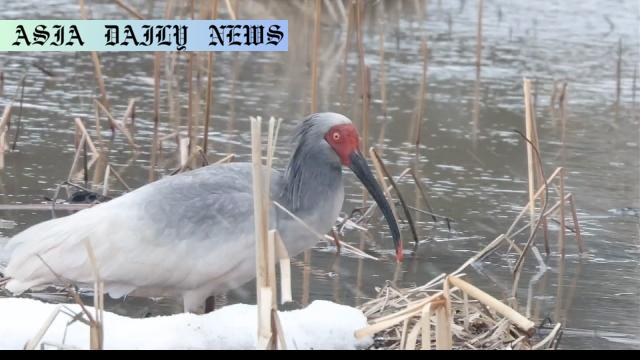Crested Ibis: Endangered birds to soar again in Noto for the first release on Japan’s main Honshu island since their extinction.
The crested ibis, extinct in Japan since 2003, is set for reintroduction in Honshu’s Noto region.
A breeding program with Chinese ibis at Sado Island has been successful, seeing 576 wild birds by December 2022.
15-20 crested ibises will be released annually starting from June next year, aiding conservation and carrying symbolic hope post-earthquake.
Locals aim to see this beautiful bird symbolizing Noto’s reconstruction and ecological restoration.

The Crested Ibis: A History of Challenges
The crested ibis, a special natural monument of Japan, once flourished across the country’s landscapes. However, due to extensive hunting and the reduction of ideal habitats, the birds became extinct in Japan by 2003, marking a significant loss for the nation’s biodiversity. The last captured crested ibis in Honshu came from the Noto region in 1970. Efforts at preservation took a positive turn with a breeding program, the fruits of which are now seen in Sado Island, Niigata Prefecture, underscoring the collective effort and cooperation between Japan and China.
Success in Sado: A Glimpse of Hope
In a commendable initiative, China donated crested ibises that became the foundation for a carefully orchestrated breeding program on Sado Island. Over time, the program has yielded remarkable success, with wild populations in and around Sado City now numbering 576 individuals as of December last year. This success has reinvigorated efforts to reintroduce the species to other parts of Japan, including regions from which they had vanished. The goal is not only to balance ecosystems but also to allow future generations to admire this natural treasure.
Plans for Honshu: The Noto Release
The Environment Ministry has announced plans to release the first batch of crested ibises in Honshu starting June next year. Approximately 15 to 20 birds will be released each year in the Noto region, which is located in Ishikawa Prefecture. Unlike Sado Island, the Noto region is on Japan’s central mainland, making it a monumental milestone in the bird’s reintroduction efforts. This plan represents a bridge between conservation science and community involvement, as the region has been chosen specifically for its rice paddies, teeming with frogs, river snails, and other creatures that can provide sustenance for the ibises.
The Role of Community in Conservation
The plan goes beyond scientific endeavors, emphasizing community participation. A website will be launched to allow residents of Noto to report sightings, fostering a sense of shared purpose and vigilance in ensuring the species flourishes. Locals, many of whom vividly remember the soil-shaking earthquake that struck in January 2024, see the ibis as a potent symbol of rebirth and recovery in the disaster-hit area. By viewing the ibis as a sign of hope and perseverance, the community is expected to become emotionally invested in the success of the program.
The Symbolism of Reconstruction
For some, like a woman in her 80s whose house was tragically destroyed by the earthquake, the return of the crested ibis signifies more than ecological success; it symbolizes a physical and emotional rebuilding of the area. This view is shared by younger generations who are eager to witness the ibis in its flight and natural habitat. For both young and old, these birds carry a message of resilience and the importance of conservation, reinforcing the interconnectedness of nature and humanity.
The Future: Sustainability and Monitoring
Releasing endangered species into the wild is just the beginning. Monitoring the birds in their new environment and ensuring their survival will be critical. Initiatives like the planned website will help gather crucial data, while local engagement ensures vigilance. The Environment Ministry’s phased release approach is strategic, allowing time for adaptation and data collection, thus reducing the risks associated with sudden changes in population distribution.
An Enduring Legacy
The reintroduction of crested ibises to Honshu may seem like a single ecological event, but its legacy could span decades. By restoring a species that once symbolized Japan’s rich biodiversity, the initiative demonstrates a steadfast commitment to balancing nature and human activities. Moreover, it offers a blueprint for other nations dealing with similar conservation challenges, highlighting the importance of international collaboration, local community involvement, and sustained efforts in ecological restoration.



Commentary
A Step Toward Ecological Restoration
The plan to reintroduce crested ibises in Honshu is not just an environmental milestone but a testament to Japan’s commitment to conservation. After years of hard work in breeding programs, the birds’ return is a reminder of the importance of protecting endangered species. It reflects the culmination of scientific advancement and collaborative efforts, proving that even when a species seems lost, hope and determination can bring remarkable results.
Cultural and Symbolic Significance
Beyond ecology, the crested ibis holds immense symbolic value for the local communities in Noto. The earthquake left destruction in its wake, but the ibis offers a beacon of hope and renewal. It is inspiring to see how both older generations, who remember the bird’s extinction, and younger ones, who are beginning to appreciate its significance, can rally around this initiative. This demonstrates how conservation can foster unity and pride in cultural heritage while addressing ecological needs.
Challenges of Sustainable Reintroduction
While optimism surrounds the project, the challenges of ensuring the birds’ survival and integration cannot be overlooked. Suitable habitats, monitoring programs, and ongoing public awareness campaigns will be critical. However, it is heartening to see that the Ministry has taken thoughtful steps to include yearly releases and community reporting systems as part of a broader strategy. With such measures in place, there is every reason to believe this reintroduction will succeed.
Broader Implications for Conservation
This effort sets a powerful example for similar ecological restoration projects worldwide. By blending science with community engagement and symbolism, Japan demonstrates an effective model for balancing progress and tradition. The crested ibis’s return signals a brighter future—not just for the bird but for all conservation efforts that aim to restore harmony between humanity and nature.